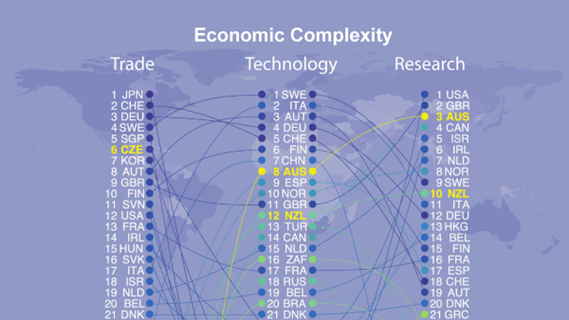Corvinus researchers designed new AI-based indicators to measure economic development more accurately
If, in addition to export data, technology patents and data on scientific articles are also taken into account using artificial intelligence (AI), it turns out that exports and technology together explain future economic growth and income inequality in countries, according to a study by the Centre for Collective Learning at Corvinus University.

In the field of economic development, it is common for scholars and practitioners to use economic complexity metrics to explain differences in economic growth, inequality, and emissions. These complexity measures summarize the geography of thousands of economic activities and are used to link an economy’s industrial fabric to key development outcomes. But complexity metrics are not without limitations. For instance, they tend to reward manufacturing heavy economies, such as Mexico and Czechia, and penalize developed extractive economies, such as Australia and New Zealand.
In a new paper1, just published in Communications Earth & Environment, a team from the Center for Collective Learning, a research group at the University of Toulouse in France and Corvinus University in Budapest, introduced a multidimensional approach to economic complexity overcoming some of these limitations. Unlike traditional approaches to economic complexity, which either use trade data or focus on a single dataset, the team combined data on exports by product, patents by technology, and research papers by scientific field to estimate three independent metrics of complexity for more than 100 countries. They then used these measures to explain international variations in economic growth, income inequality (Gini index), and the intensity of greenhouse gas emissions (emissions per unit of GDP), finding that the multidimensional approach significantly improved the ability of these methods to explain economic growth, inequality, and emissions.
The team found that exports and technology combine to explain future economic growth and income inequality, and that countries that score well in all three measures exhibit a lower intensity of greenhouse gas emissions. This comes from the fact the three measures correct one another. For example, Australia, which ranks 76th in trade complexity, jumps to the 8th and 3rd positions, respectively, when it comes to technology and emissions. Hungary follows the opposite pattern. It is ranked 15th in trade complexity, but 24th and 30th, respectively, on technology and research. This could be explained in part by the fact that Hungary’s exports do not serve global markets but the value chains of their neighbors.
“This provides a significant advancement for the field. For more than a decade economic complexity metrics have been limited mostly to exports data. Now we have solid proof that these methods can be expanded to create multidimensional representations of various economic activities.” Said Viktor Stojkoski, a fellow at the Center for Collective Learning and first author of the study.
“This research addresses important and valid criticisms to economic complexity methods, showing that some key limitations can be overcome by expanding the datasets used to construct these metrics.” Said César Hidalgo, director of the Center for Collective and senior author of the study.
The field of economic complexity has been a flagship case of the use of Artificial Intelligence methods in economics. This research helps solidify the contributions of this interdisciplinary effort at a time when Artificial Intelligence is on everyone’s mind.
1. Stojkoski, V., Koch, P. & Hidalgo, C. A. Multidimensional economic complexity and inclusive green growth. Commun Earth Environ 4, 1–12 (2023).